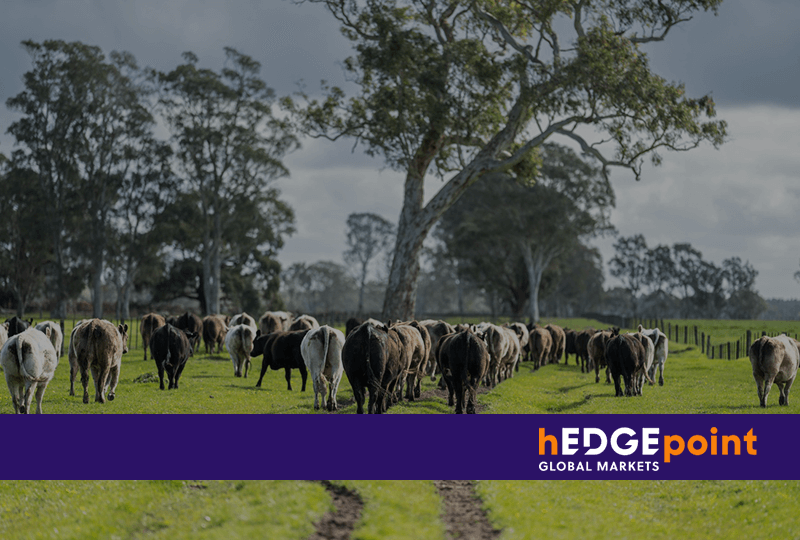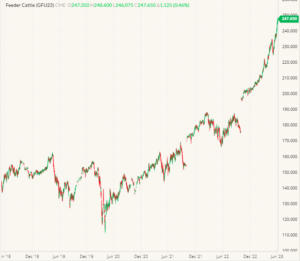
Animal protein commodities are products of animal origin that are traded on international markets as basic homogeneous goods. In addition, they’re widely m

Animal protein commodities are products of animal origin that are traded on international markets as basic homogeneous goods. In addition, they’re widely marketed and have prices that are influenced by several factors, including supply and demand, weather conditions, animal feed, government policies, socio-political conflicts, economic changes, and diseases.
Animal protein includes a variety of products, such as beef, pork, poultry, lamb, fish, dairy products, eggs, and other animal derivatives. These goods are produced on an industrial scale and are subject to specific standards and regulations to ensure food safety and quality.
Currently, it’s a sector characterized by a complex, challenging world context. The COVID-19 pandemic, for example, significantly impacted supply and demand, as well as prices. One of the countries most affected by that scenario was the U.S.
In this article, you’ll understand more about the beef and pork scenario in the North American nation, and why there’s the risk of collapse, highlighting again the importance of risk management.
John Payne, hEDGEpoint Relationship Manager in the U.S., explains the main challenge of the country’s beef market: “We’re at a point where there aren’t many animals available in the short term. The supply of cattle has been decimated in the last five years because of unprofitable farms, COVID-19, and extreme drought. Farmers are now being encouraged to increase herds, but it’s a long process with varying costs,” Payne explains.
After the pandemic, demand increased again, but the beef production cycle takes time and typically doesn’t keep pace with consumption. Just to give you an idea: the herd of beef cows in the country has dropped to its lowest level since 1962, according to data from the United States Department of Agriculture (USDA).
One of the reasons for this drastic reduction was the extreme drought suffered by the U.S. in 2022. As a result, animal feed costs rose, as adverse weather reduced the amount of available pasture. Thus, ranchers sent fewer and fewer cows to slaughter, instead of keeping them to breed.
Another relevant issue is the amount of hay available. A sizable portion of the U.S. cattle herd still faces the effects of drought, even though conditions have improved. This has resulted in hay shortages, with May 1 stocks down 13% from 2022, the lowest level in a decade.
Hence, the reduced supply of hay may not be enough to compensate for poor pastures and may not sustain herds in the North American summer, in turn affecting reproduction. Due to this, the USDA states that the slaughter of beef cows will continue at a relatively high rate.
As a result, Payne forecasts a significant rise in this commodity’s prices due to the low market supply, as we can see in the graph below:

Given these factors, the USDA estimates that world beef production should decrease by 0.2% in 2023. The drop is mainly due to the cuts in production in the U.S.: the country should total 12.01 million tons, an amount that’s 6.3% lower than in 2022. The projections of Dutch bank Rabobank indicate that beef production in the U.S. should decrease from 400 to 500 thousand tons per year until 2026.
In the U.S. pork market, domestic demand is slower this year. Inflation continues to reduce the population’s purchasing power and slow down the economy. The USDA points out that U.S. commercial production is forecast to be 1.4% higher in 2023, totaling around 12.4 million tons, with a gradual increase in hog harvests along with higher weights.
This situation contributes to a greater supply of pork in relation to domestic consumption. Therefore, prices have been reduced and represent an extremely attractive value for large importers, such as China and Mexico. The USDA forecasts slightly higher exports to Japan and South Korea as well, due to the country’s increased competitiveness versus the European Union. Above all, the growth is due to greater demand from these Asian countries, as consumption is recovering towards pre-pandemic levels.
Another important aspect that could further increase U.S. export volumes is a new outbreak of African Swine Fever (ASF) in China, the main exporter and importer of pork on the planet. Disruptions in Chinese supply chains should lead to the reorganization of global protein markets, as well as possible price increases.
According to hEDGEpoint analysis, in the short term, the market shouldn’t suffer from the PSA problem in China, as supply is high. “What could happen is a trend of increasing imports from China in the long term, in case there’s an outbreak of PSA again,” Payne points out.
Given the current scenario for U.S. beef and pork, we’ve identified some key factors that could lead to a collapse:
Payne explains that the risk of collapse lies in the logic of the sector’s production chain: “You can’t increase or decrease production quickly. The reproductive process takes longer, especially for beef, and there’s also the need for more feed when reproduction increases.”
In the case of pork, ASF could affect U.S. production in the future. Losses could average $7.5 billion a year, according to Iowa State University economist Dermot Hayes.
This would happen because exports would be lost, and some of the products that could have gone to China would be processed, thus becoming useless or losing a lot of value. But much of the muscle meat would end up on the domestic market, increasing consumption by up to 30%, and causing a huge drop in prices, according to Hayes.
Regarding climate change, FAIR’s Climate Risk Tool indicates that climate-related costs may affect agricultural production, such as higher feed prices and expected carbon taxes. The increase in the price of feed will be responsible for 5% of the cost increases for livestock companies, posing yet another obstacle for industries. The expected carbon taxes on emissions from livestock production will represent 4% of the cost increase.
The animal protein scenario in the U.S. is a case that leaves no doubt: the commodity market is extremely volatile. Economic, political, and climatic changes constantly interfere with production and prices.
Possessing a plan that provides security is vital for agents involved in this global chain. Therefore, using risk management strategies is essential. With hedging products, expert knowledge, and market intelligence analysis, hEDGEpoint offers you all the support for the best futures trading experience possible.

Rua Funchal, 418, 18º andar - Vila Olímpia São Paulo, SP, Brasil
Contato
(00) 99999-8888 example@mail.com
Section
Home
O que Fazemos
Mercado
Quem Somos
HUB
Blog
Esta página foi preparada pela Hedgepoint Schweiz AG e suas afiliadas (“Hedgepoint”) exclusivamente para fins informativos e instrutivos, sem o objetivo de estabelecer obrigações ou compromissos com terceiros, nem de promover uma oferta ou solicitação de oferta de venda ou compra de quaisquer valores mobiliários, commodity interests ou produtos de investimento.
A Hedgepoint e suas associadas renunciam expressamente a qualquer uso das informações contidas neste documento que direta ou indiretamente resulte em danos ou prejuízos de qualquer natureza. As informações são obtidas de fontes que acreditamos serem confiáveis, mas não garantimos a atualidade ou precisão dessas informações.
O trading de commodity interests, como futuros, opções e swaps, envolve um risco substancial de perda e pode não ser adequado para todos os investidores. Você deve considerar cuidadosamente se esse tipo de negociação é adequado para você, levando em conta sua situação financeira. O desempenho passado não é necessariamente indicativo de resultados futuros. Os clientes devem confiar em seu próprio julgamento independente e/ou consultores antes de realizar qualquer transação.
A Hedgepoint não fornece consultoria jurídica, tributária ou contábil, sendo de sua responsabilidade buscar essas orientações separadamente.
A Hedgepoint Schweiz AG está organizada, constituída e existente sob as leis da Suíça, é afiliada à ARIF, a Associação Romande des Intermédiaires Financiers, que é uma Organização de Autorregulação autorizada pela FINMA. A Hedgepoint Commodities LLC está organizada, constituída e existente sob as leis dos Estados Unidos, sendo autorizada e regulada pela Commodity Futures Trading Commission (CFTC) e é membro da National Futures Association (NFA), atuando como Introducing Broker e Commodity Trading Advisor. A Hedgepoint Global Markets Limited é regulada pela Dubai Financial Services Authority. O conteúdo é direcionado a Clientes Profissionais e não a Clientes de Varejo. A Hedgepoint Global Markets PTE. Ltd está organizada, constituída e existente sob as leis de Singapura, isenta de obter uma licença de serviços financeiros conforme o Segundo Anexo do Securities and Futures (Licensing and Conduct of Business) Act, pela Monetary Authority of Singapore (MAS). A Hedgepoint Global Markets DTVM Ltda. é autorizada e regulada no Brasil pelo Banco Central do Brasil (BCB) e pela Comissão de Valores Mobiliários (CVM). A Hedgepoint Serviços Ltda. está organizada, constituída e existente sob as leis do Brasil. A Hedgepoint Global Markets S.A. está organizada, constituída e existente sob as leis do Uruguai.
Em caso de dúvidas não resolvidas no primeiro contato com o atendimento ao cliente (client.services@hedgepointglobal.com), entre em contato com o canal de ouvidoria interna (ombudsman@hedgepointglobal.com – global ou ouvidoria@hedgepointglobal.com – apenas Brasil) ou ligue para 0800-8788408 (apenas Brasil).
Integridade, ética e transparência são valores que guiam nossa cultura. Para fortalecer ainda mais nossas práticas, a Hedgepoint possui um canal de denúncias para colaboradores e terceiros via e-mail ethicline@hedgepointglobal.com ou pelo formulário Ethic Line – Hedgepoint Global Markets.
Nota de segurança: Todos os contatos com clientes e parceiros são realizados exclusivamente por meio do nosso domínio @hedgepointglobal.com. Não aceite informações, boletos, extratos ou solicitações de outros domínios e preste atenção especial a variações em letras ou grafias, pois podem indicar uma situação fraudulenta.
“Hedgepoint” e o logotipo “Hedgepoint” são marcas de uso exclusivo da Hedgepoint e/ou de suas afiliadas. O uso ou reprodução é proibido, a menos que expressamente autorizado pela HedgePoint.
Além disso, o uso de outras marcas neste documento foi autorizado apenas para fins de identificação. Isso, portanto, não implica quaisquer direitos da HedgePoint sobre essas marcas ou implica endosso, associação ou aprovação pelos proprietários dessas marcas com a Hedgepoint ou suas afiliadas.
aA Hedgepoint Global Markets é correspondente cambial do Ebury Banco de Câmbio, de acordo com a resolução CMN Nº 4.935, DE 29 DE JULHO DE 2021, Artigo 14 do Banco Central do Brasil (BACEN).
Para mais informações sobre nosso parceiro, serviços disponíveis, atendimento e ouvidoria, acesse o link a seguir: https://br.ebury.com/